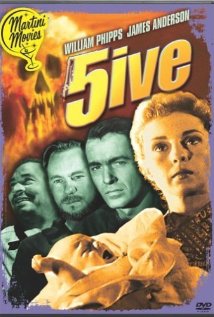‘Five’ is the sort of science fiction I enjoy: long on ideas, short on rayguns and F/X. That’s very likely why the movie flopped: most filmgoers seem to think that science fiction should have a big special-effects budget and no ideas at all.
This Cold War film depicts the fate of five desperate survivors in California after a nuclear war has wiped out nearly all human life. The film’s atmosphere greatly benefits from the fact that its five cast members are all obscure actors, not recognisable from work elsewhere. Interestingly, the most familiar face in this cast is also the movie’s only African-American: Charles Lampkin, who later portrayed the only black man in Mayberry. Lampkin also gives the best performance in ‘Five’, at one point reciting James Weldon Johnson’s lyrical poem ‘The Creation’.
‘Five’ is very much the personal vision of Arch Oboler, a writer now unjustly forgotten. Like Rod Serling (whom Oboler influenced), Oboler wrote in several genres but found that he could best put his ideas forward in the anthology format, and in the genres of science fiction and dark fantasy. Also like Serling, Oboler wrote scripts in several media but only had real success in one medium: television for Serling, radio for Oboler. Arch Oboler’s science-fiction and horror radio series were the direct forebears of ‘The Twilight Zone’ and ‘Night Gallery’.
The film’s title — ‘Five’ — is somewhat of a misnomer, as one of the survivors (Mr Barnstaple) dies just before the arrival of another (Eric), so we never have interplay between more than four people. The film’s ultra-low budget is cleverly used, especially in the sequences when Roseanne (pregnant with the child of her deceased husband) visits the dead metropolis, now a shattered necropolis. ‘Five’ also benefits from Oboler’s choice of locations: he shot most of this film inside the rooms and on the grounds of his mountainside house, designed and landscaped by Frank Lloyd Wright. As with many of Wright’s designs, there’s a slightly askew quality to this house that brings an other-worldly undertone to this very still, very moody drama.
Some reviewers of ‘Five’ seem to regard the five protagonists as archetypes: for instance, the banker Mr Barnstaple, now senile and useless — he doesn’t even realise that the war has taken place — allegedly represents Capital, now obsolete in a world where money is useless. I disagree. Barnstaple worked in a bank, but he wasn’t an executive: he was an elderly clerk who happened to be in the underground vault when the bomb went off. If we’re going to label these characters, then Barnstaple is white-collar labour, while Charles (the black man) is blue-collar labour. Michael, I guess, represents humanity’s artistic side.
James Anderson, giving a James Mason-like performance, is excellent as the human snake in this post-apocalypse Eden. He portrays the elitist (not elite) intellectual, who clearly deems himself superior to Charles but avoids saying so until late in the proceedings, when he finally reveals his racial attitude. ‘So … now it comes out,’ says Charles, who has clearly encountered racism before.
Lampkin’s performance is excellent, but I felt that he and Oboler tried a bit too hard to establish his character as a virtuous black man. When Roseanne, the only female survivor, accepts Michael as her lover, Charles basically moves out of the house and sleeps rough in the back garden so that this Adam and Eve can have the place to themselves. I thought it would have been more realistic to depict all four survivors sharing the house, with Roseanne and Michael established as sharing one room, and the other two men sleeping elsewhere under the same roof.
Oboler gave himself a tough assignment with this project. It’s not surprising that this film went belly-up at the box-office, and that Oboler’s next projects were mindless entertainment (‘Bwana Devil’) and silly comedy tricked up as science fiction (‘The Twonky’). ‘Five’ is real SF, and I’ll rate this brave effort 8 out of 10.

